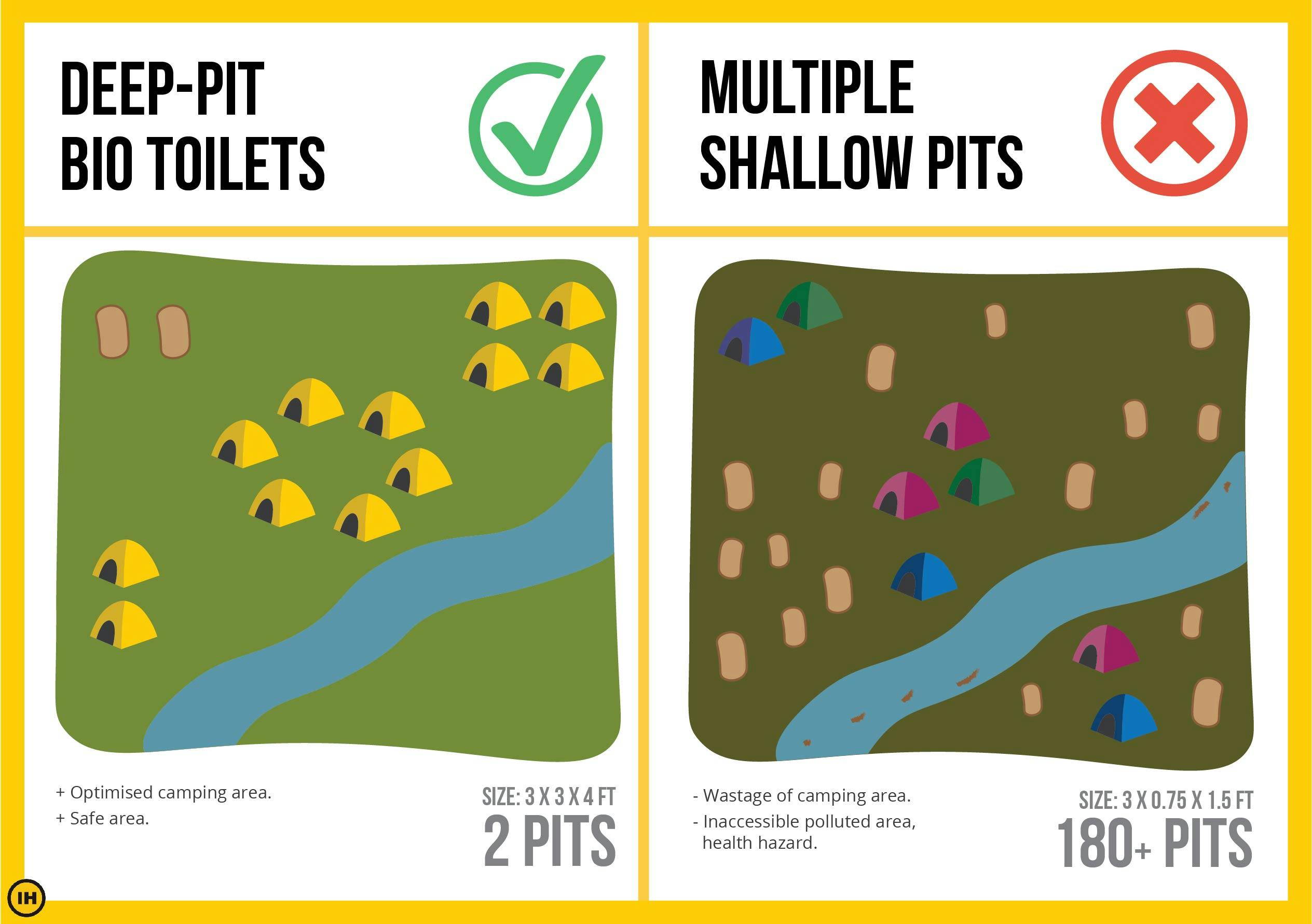Why Deep Bio Toilet Pits Are Ideal For Human Waste Management on Himal...
Share this story
Why Deep Bio Toilet Pits Are Ideal For Human Waste Management on Himalayan Treks
Category Green Trails Impact Reports Green Trails Sustainability Resources Expert Opinion
By Lakshmi Selvakumaran
2021-08-21
Of late, many questions are being raised about what is a sound toilet system at high-altitude campsites on popular treks.
On the one hand, we have multiple organizations digging up one shallow toilet pit daily at each campsite.
On the other hand, we have our human waste management system — 1-2 deep toilet pits at each campsite for the whole season. It’s what we follow across all slopes, on all our treks, at all campsites between 8,000 and 13,000 ft.
Many officials, and local authorities have questioned this practice. Our tents and stoves have been confiscated. Defamatory videos have been posted sharing false information, calls to ban Indiahikes, and our teams on the slopes have been threatened.
Yet, we firmly hold our ground about our human waste management system at high altitude camps — 1-2 large deep pits that last easily for 25 groups. These toilets are the only way forward to trek sustainably and protect the environment.
In this post, we’d like to clarify why deeper pit systems are better for the environment and why they are followed worldwide.
Why Deep-Pit Bio Toilets are Better for Human Waste Management at High Altitude Camps
When Indiahikes started, our human waste management system on treks was rudimentary. It was manageable since there weren’t too many trekkers.
We started with trekkers digging individual cat holes and covering them after use. When the number of trekkers grew, we dug shallow pits that were about 1.5 ft deep and ¾ ft wide and 1 ft long. Before moving from the campsite, these pits were closed.
But over time, we noticed a huge problem. More and more organizations were trekking. Each organization was also following this model of human waste management. Within a span of a week, each campsite had about 50 pits.
We realized that trekking in India cannot grow this way (Read the story of how our toilets evolved).
For everyone to trek without damaging the environment, we needed to find a more efficient way of managing toilets on a trek.
- We needed toilets big enough to last the entire trekking season.
- We needed toilets capable of degrading human waste within a span of 3-4 months.
We studied what was done in high altitude and cold climate zones across the world — European countries, Alaska, even the North and South Poles. Closer home, we studied what happened at Ladakh and Spiti.
We noticed that the most environmentally evolved countries use deep pit systems, for obvious benefits towards the environment.
Over time, we switched to these deep pit bio toilets in Uttarakhand and Himachal and more recently, in Jammu & Kashmir.
Here’s what we observed to be the benefits of deep pit toilets.
Benefit 1: Deep pits protect over 80% of the campsite area from spread of human waste
We’d like to give you some numbers here.
On any popular Himalayan trek, we have seen over 200-250 trekkers in a day on the trail, trekking with multiple organizations. For extremely popular treks like Kashmir Great Lakes and Kedarkantha, the number is a lot higher.
Each day, around 15 shallow toilet pits are dug at EACH campsite by other organizations. Over two months, that’s 900 TOILET PITS at each campsite.
We have seen that these pits are not used properly. They are often not closed properly. They are not covered with mud. They have toilet paper and everything else out in the open. Every ten steps you take, you step in a toilet pit.
The impact of 900 toilet pits at each campsite at the end of the season is enormous.
This is where deep toilet pits make better sense for the environment.
With deep pit bio toilets, you need just 1-2 pits per campsite easily for 25 groups. The dimensions we use for these toilets are 3 ft long, 3 ft wide and 4 ft in depth. From our studies, these pits are efficient enough to handle the human waste of over 25 groups of trekkers. That’s around 625 trekkers.
This limits the presence of human waste to one known area of the campsite. Consequently, it protects around 80% of the campsite area from being dug out for use as toilet pits.
If every organization can dedicate 2 deep toilet pits to themselves, it would be an efficient human waste management system to protect the environment.
Better yet, if there could be 3-4 well-maintained deep toilet pits for the entire campsite, for use by all organizations, that would be the best way forward for the environment. But maintenance is key here, which requires dedicated infrastructure, people and systems in remote areas of the Himalayas. Until this is possible, each organization must maintain their own deep pits.
Although the biggest and the most obvious benefit of such a toilet is the reduction in the number of toilet pits being generated, there are countless other benefits towards the environment that must be considered.
Benefit 2: Deeper pit = faster decomposition. Shallow pit = slower decomposition.
The process of composting benefits from a lot of heat. Composting is both an exothermic and endothermic process. Endothermic because the rate of composting is directly correlated to the temperature inside the pit. Second, the composting process also produces a lot of heat which is essential to kill the harmful bacteria that is present inside the compost.
A typical compost pit goes from 25 deg C till 80 deg C and back within the span of the composting process.
Source: untamedscience.com
However, on our mountain trails, the ambient temperature falls heavily at night, sometimes even in the negative degrees. A simple solution to trap and retain the heat within the compost pit is to dig deep pits. It does not let the ambient temperature affect the composting process.
In our experience, the bigger size of the pit, in addition to use of cocopeat / sawdust as a carbon element has helped decompose human waste within a span of 3 months.
Benefit 3: Deep pits protect the topsoil from permanent damage, and if managed well, can make the soil richer
The most precious layer of the soil in an ecosystem is the topsoil. With multiple shallow pits, the amount of topsoil removed is significantly higher than the amount of topsoil lost while digging deep pit toilets. This becomes evident with a simple calculation.
For 45 groups with approximately 25 trekkers in each group, we need 135 shallow pits.
Calculating the surface area of the top soil removed, this equates to about 200 sq ft of topsoil lost (Each shallow pit is around ¾ ft wide and 1 ft long).
However, with 2 deep pit bio toilets, we are looking at just 18 sq ft of topsoil being removed per pit. This protects a huge area of topsoil, which contains all the nutrients needed for grasslands to thrive.
At Indiahikes, we dig 1-2 deep toilet pits at each campsite. We use this for two months, throughout the season. We use cocopeat / sawdust to bring in carbon to help decomposition.
We cover the pits spending almost an entire day to ensure the process is followed properly. Within 3-4 months, this human waste decomposes and there’s fresh grass growing on top. Because of the way we use our pits, the soil is RICHER after decomposition, leaving the earth with well-balanced, nutritious manure.
Benefit 4: Deep toilet pits protect water sources
Let’s talk about contamination of water sources.
Everyone knows that campsites have to be around water sources. The moment you continuously dig multiple shallow pits for toilets, the more spread out human waste is going to be. We have seen toilet pits go as far as the banks of streams and lakes, contaminating water sources almost immediately.
On the other hand, deep pit bio toilets help in containing human waste to a specifically designated area. At Indiahikes, we ensure that our pits are as far as possible from the water sources.
From our studies, ideally, the toilets must be at least 150 ft away from any water source. With a landmine of shallow pits, this becomes an impossibility to maintain in a public campsite.
Added to this, the deep pits degrade human waste more efficiently, which again neutralizes the threat of the pathogens in human waste from entering water sources.
Benefit 5: Deep pit bio toilets are reusable
A big benefit of a deep toilet pit is its reusability. In all our camps, we use our toilet pits in the same place again and again every year. This has again helped contain the human waste management to a singular location within the campsite, creating a safe place for everyone to camp and enjoy the outdoors peacefully.
With shallow pits, we suffer from incomplete decomposition, problems with wet wipes and toilet papers spread throughout the campsite. This makes it difficult to reuse the pits again. It creates an unnecessary need to dig out more and more shallow pits, causing long term damage to the environment over many years.
Conclusion
Indian trekking is growing every year. Trekkers are trekking on their own. Organisations are cropping up on many scales.
At Indiahikes, we firmly believe that everyone must trek. It’s a sport that brings about a lot of good in people’s lives. But the stark reality of the trekking world today is that we cannot grow trekking without solving fundamental problems like waste management at high altitudes.
At the end of the day, we need innovative solutions like deep pit bio toilets to effectively manage human waste and create more capacity for more people to trek sustainably.
These scientific solutions must be accepted and encouraged. In fact, for trekking to be done responsibly, these innovative solutions must be made the norm of how trekking is done in India.
Related Videos
Sign up for our much loved Weekly Mailer
We have terrific trekking tips, trek updates and trek talks to look forward to

